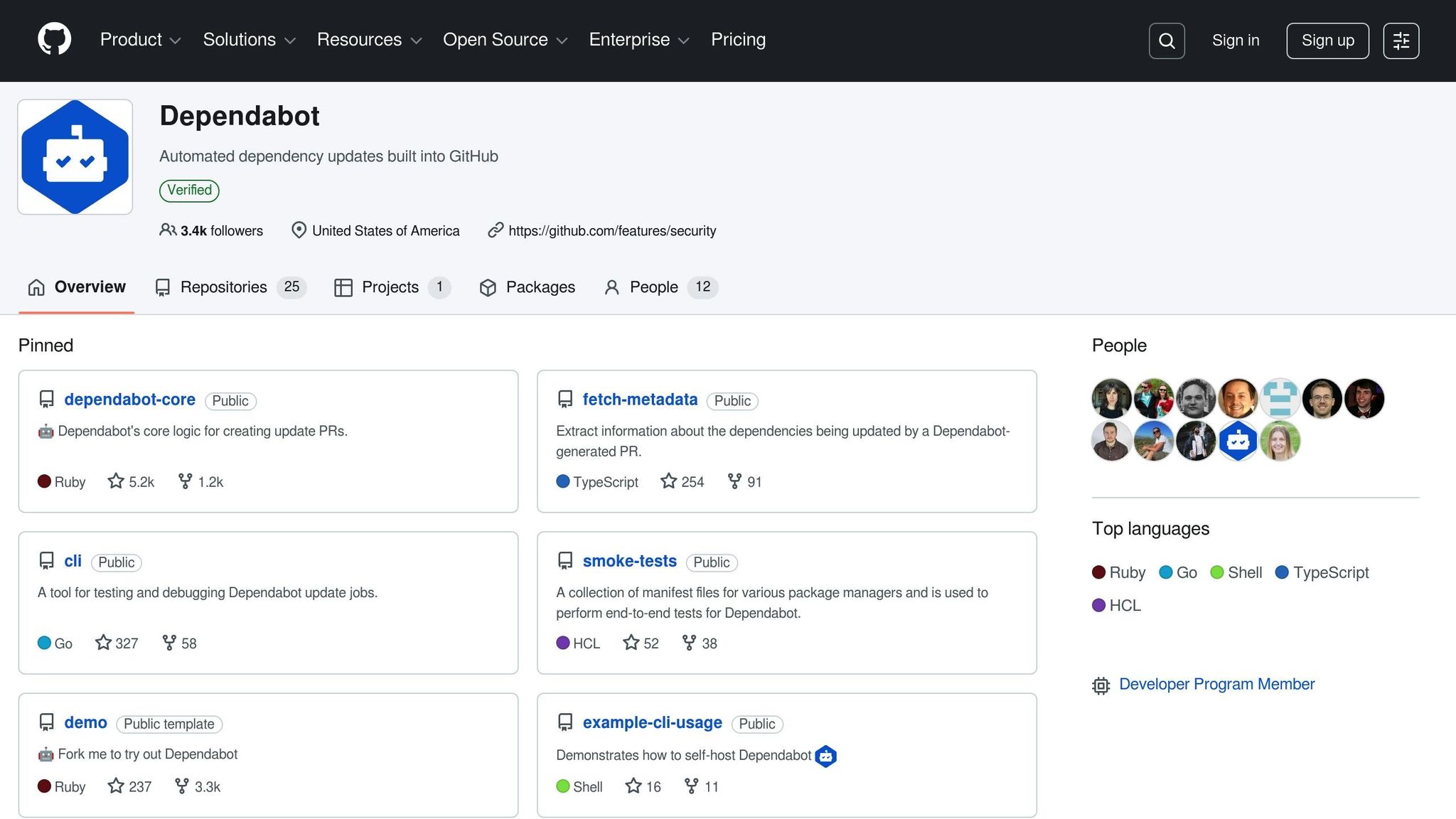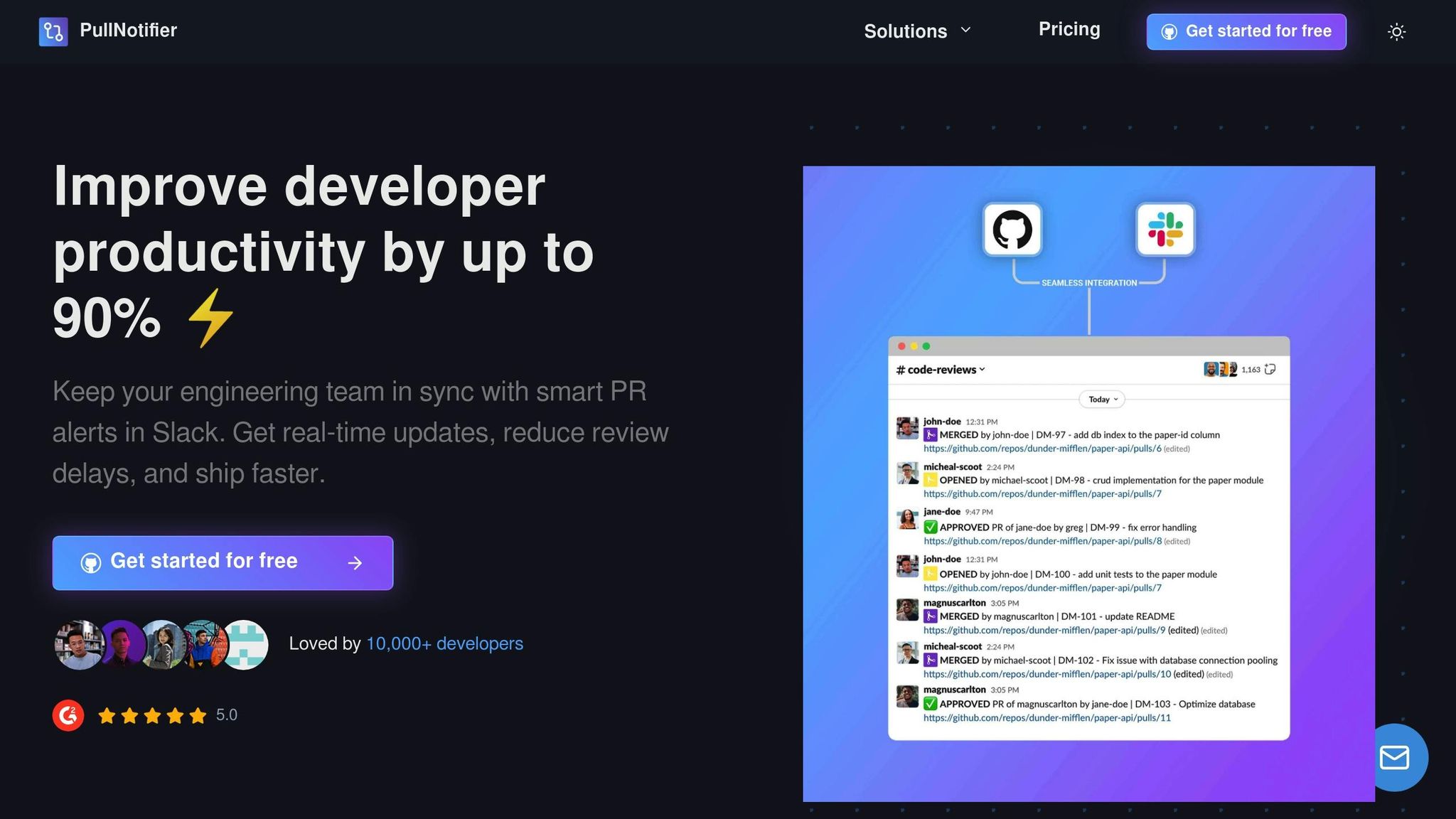- Published on
Dependabot vs. Renovate: Dependency Update Tools
- Authors

- Name
- Gabriel
- @gabriel__xyz
Dependabot vs. Renovate: Dependency Update Tools
Dependabot and Renovate are tools that automate dependency updates, helping developers maintain secure and stable codebases. Here's a quick breakdown:
- Dependabot: Built into GitHub, it's simple to set up and best for GitHub-only projects. Ideal for smaller teams or straightforward workflows. Limited package manager support and customization.
- Renovate: Works across multiple platforms (GitHub, GitLab, Bitbucket, etc.) with advanced configuration options. Handles complex setups like monorepos and offers robust grouping features. Steeper learning curve but more flexibility.
Quick Comparison
| Feature | Dependabot | Renovate |
|---|---|---|
| Platform Support | GitHub only | GitHub, GitLab, others |
| Package Managers | ~14 | 90+ |
| Update Grouping | Limited | Advanced |
| Auto-Merge | Basic | Highly configurable |
| Ease of Use | Easy setup | Requires more setup |
| Monorepo Support | Limited | Strong |
Choose Dependabot for simplicity and GitHub-exclusive projects. Pick Renovate if you need advanced features or work across platforms. Some teams even use both for different purposes.
Automating dependency updates - Dependabot vs Renovate

Dependabot: Features and Benefits
Dependabot is GitHub's built-in tool designed to streamline dependency management by automating updates, addressing security vulnerabilities, and keeping versions current.
Main Features
Dependabot keeps an eye on dependencies across various ecosystems and automatically creates pull requests when updates are available [1].
It identifies security vulnerabilities, sends alerts, and generates pull requests with fixes as soon as advisories are published. Supported environments include JavaScript (package.json), Python (requirements.txt), Ruby (Gems), and Docker (Dockerfiles).
Each pull request includes helpful details like release notes, changelogs, commit information, and sometimes compatibility scores. These features aim to ensure updates don’t disrupt your dependency graph.
Setup and Configuration
Dependabot is automatically enabled for repositories that opt in. For more control, you can add a dependabot.yml file to the .github directory. This file allows you to customize update schedules, specify ecosystems, and decide which dependencies to include.
To reduce pull request clutter, security updates can be grouped together. Dependabot also supports private registries, making it adaptable to a variety of setups.
Limitations
While Dependabot is a powerful tool, it does have its challenges. One key limitation is its lack of contextual understanding of your repository, which can sometimes lead to compatibility issues [2]. As Allie Fitter points out:
"Dependabot lacks the ability to assess the impact of a dependency update on your specific repo." – Allie Fitter [2]
Dependabot relies on developers to manually review changelogs for breaking changes. It also enforces strict limits on pull requests - five initially, 10 for security updates, and a default of five for version updates [2][3].
In larger repositories, Dependabot may time out or struggle with complex dependency graphs and private dependencies. It’s less effective for heavily outdated dependencies that require significant upgrades, and its configuration can occasionally result in false positives or negatives [4].
Next, we’ll explore Renovate and its features to provide a more complete comparison of dependency update tools.
Renovate: Features and Benefits
Renovate is a powerful tool for managing dependencies across multiple platforms like GitHub, GitLab, Bitbucket, Azure DevOps, and AWS CodeCommit. It's especially useful for organizations that juggle various development environments. Below, we’ll dive into its standout features and setup options, as well as some challenges to consider.
Main Features
Renovate supports over 90 package managers, covering everything from JavaScript and Python to Docker and Kubernetes, even accommodating custom formats. This makes it a versatile choice for teams working with diverse technologies.
The Dependency Dashboard acts as a central hub to monitor all detected dependencies, open pull requests, and updates - whether pending or failed. This feature helps teams quickly assess the state of their dependencies and decide which updates to prioritize.
With grouped updates, related dependencies are bundled into a single pull request. This approach reduces clutter and makes it easier to review changes in complex projects.
Renovate also provides detailed update insights. Beyond version numbers, it offers data like adoption rates, the age of the new version, and merge confidence scores. These insights empower developers to decide whether to accept an update immediately or investigate further.
For teams with unique needs, Renovate handles non-standard dependency formats seamlessly, managing versions in custom file formats. Plus, shareable config presets allow organizations to maintain consistent practices across multiple repositories without repetitive setup.
Setup and Configuration Options
Renovate’s configuration revolves around the renovate.json file, which can be stored in the root of your repository or, for GitHub projects, in .github/renovate.json. The file supports JSONC, enabling inline comments for clarity.
Teams have extensive control over updates through package rules. For example, you can set different strategies for major and minor updates, group related packages, or apply specific rules to internal dependencies. A common setup might include automatic merging for minor updates while requiring manual reviews for major changes.
With scheduling options, teams can decide when updates are processed. By default, lock file updates occur at 4:00 AM on Mondays, but this can be adjusted to fit your workflow.
Renovate also supports auto-merge capabilities, which can be configured for low-risk updates. This reduces manual effort for routine updates while relying on automated testing to ensure reliability.
"Renovate is extremely configurable, with dozens of configuration options to tune your experience... but configurable enough that it's very likely you can do what you need to with it." – Jamie Tanna, Software Engineer [5]
For organizations requiring private package registries, Renovate offers self-hosting options. This is particularly beneficial for teams operating behind firewalls while still wanting automated dependency management.
While these features showcase Renovate's flexibility, they do come with some challenges.
Limitations
One of the main hurdles with Renovate is its steep learning curve. The sheer number of configuration options, while powerful, can be overwhelming for teams new to the tool.
Another challenge is over-customization. Teams may spend too much time fine-tuning settings that could be handled adequately with defaults. This can lead to additional maintenance work, as team members need to understand and manage complex configurations.
Finally, for teams already heavily integrated with GitHub, Renovate’s separate setup requirements might feel like an extra step compared to Dependabot, which offers built-in support. This added layer of installation and configuration could be seen as a drawback for some organizations.
Dependabot vs. Renovate Comparison
Now that we've looked at each tool individually, let's compare them side by side. The decision between Dependabot and Renovate often hinges on your team's specific needs, the complexity of your projects, and your preferred platforms.
Feature Comparison Table
Here's a detailed look at how these two dependency management tools stack up against each other:
| Feature | Renovate | Dependabot |
|---|---|---|
| Platform Compatibility | Works with GitHub, GitLab, Bitbucket, Azure DevOps, and self-hosted setups | GitHub only |
| Package Manager Support | Supports over 30 package managers | Limited to 14 package managers |
| Customization Depth | Offers extensive configuration options | Provides limited configuration options |
| Dependency Dashboard | Includes a comprehensive monitoring dashboard | Offers a basic view in GitHub's security tab |
| Update Grouping | Advanced grouping strategies available | Limited grouping capabilities |
| Monorepo Handling | Handles monorepos efficiently, updating shared packages together | Limited, no grouped updates for monorepos |
| Scheduling Options | Flexible scheduling with cron expressions | Basic scheduling intervals: daily, weekly, monthly, or quarterly |
| Automated Merging | Highly configurable auto-merging options | Limited auto-merging capabilities |
| Learning Curve | Steeper due to its extensive features | Easier to learn due to its simplicity |
| Self-Hosting | Fully supported for greater control | Not available, works only on GitHub-hosted environments |
This table highlights the key differences, showing how each tool fits into different workflows. According to GitHub's 2023 Octoverse report, repositories that use automated dependency updates see 40% fewer security vulnerabilities than those that don't [6]. This makes choosing the right tool essential for maintaining a secure and up-to-date codebase.
Renovate stands out for its flexibility and advanced features. With support for over 30 package managers and a centralized dependency dashboard, it’s a strong choice for teams managing complex or diverse tech stacks. In contrast, Dependabot's simplicity and seamless GitHub integration make it a great option for smaller projects or teams looking for a quick and easy setup.
Which Tool to Choose
Dependabot might be the right fit if you:
- Work exclusively within the GitHub ecosystem
- Have smaller projects with straightforward dependency needs
- Want a quick setup with minimal configuration
- Are new to automated dependency management and need a simple starting point
Dependabot’s built-in GitHub integration makes it incredibly easy to enable. With just a few clicks, you can start automating updates, making it perfect for startups or small teams focusing on product development rather than tooling.
Renovate might be better suited if you:
- Manage monorepos or complex project structures
- Use multiple platforms like GitLab, Bitbucket, or Azure DevOps
- Need advanced update grouping and scheduling options
- Require self-hosting for greater control
- Work with a variety of package managers across diverse tech stacks
For enterprise teams, Renovate’s advanced capabilities outweigh its steeper learning curve, especially when managing large, complex projects. Its ability to handle monorepos and reduce pull request clutter makes it a strong contender for teams looking to streamline their workflows.
Interestingly, some teams use both tools - Dependabot for security alerts and Renovate for regular dependency updates [7].
Ultimately, the right choice depends on your team’s priorities and development ecosystem. These comparisons should help you align your decision with your specific requirements, setting the stage for seamless integration.
GitHub and Slack Integration

Keeping teams informed in real-time is crucial, especially when managing dependencies. By integrating GitHub with Slack, you can ensure your team stays up to date without unnecessary delays. Let’s explore how tools like Dependabot and Renovate handle dependency updates within GitHub, and how Slack notifications can elevate the process.
Dependabot with GitHub
Dependabot’s built-in integration with GitHub is one of its standout features. Once activated, it automatically creates pull requests whenever updates are available, focusing on security patches as a priority. For example, if GitHub’s security advisories detect vulnerabilities in your dependencies, Dependabot immediately generates pull requests with the required fixes. This eliminates the need for extra apps or complicated workflows [6].
However, Dependabot has its limitations. It’s designed exclusively for GitHub, which can be restrictive for teams using multiple platforms. Additionally, its fixed scheduling options and limited grouping capabilities often result in numerous individual pull requests, potentially cluttering workflows.
For teams looking for more flexibility, Renovate offers a broader range of configuration options.
Renovate with GitHub
Renovate brings advanced features to the table, though it requires installation or self-hosting. Its flexible scheduling, powered by cron expressions, and its ability to group pull requests make it a strong option for teams with complex workflows. For instance, Renovate shines in monorepo environments, where it can update shared packages collectively, reducing the number of pull requests and simplifying reviews [6].
Another advantage is its dashboard, which provides a detailed, real-time view of dependency statuses - something Dependabot’s basic security tab lacks. Renovate also supports multiple platforms, including GitLab, Bitbucket, and Azure DevOps, allowing teams to maintain consistency across different tools [6].
"Renovate is the Swiss Army knife of dependency bots. It's aggressively configurable, which is great… if you love control (or have a PhD in YAML)."
– Alex Aslam [7]
While both tools excel at automating updates, pairing them with smarter notification systems can significantly enhance team workflows.
Better Notifications with PullNotifier

GitHub’s default notification system often generates unnecessary noise, making it easy to miss critical updates. PullNotifier steps in to solve this problem by delivering real-time pull request notifications directly to Slack. Unlike GitHub’s official Slack integration, PullNotifier updates messages in place instead of creating a new message for every change, reducing clutter and improving clarity.
"The best thing about this integration is that it doesn't spam your Slack channel. It updates the message in place unlike the official GitHub integration w/c adds a new message every time the PR changes."
– Mike D., Senior Engineer @ Mash [8]
PullNotifier also allows teams to map repositories to specific Slack channels, ensuring that notifications are targeted and relevant. This feature is particularly useful for larger organizations, where teams work on multiple repositories. With customizable rules based on pull request labels, authors, or reviewers, the tool adapts to various workflows seamlessly.
The setup takes less than a minute, and the results speak for themselves - teams using PullNotifier report productivity boosts of up to 90%. Over 10,000 engineers across 500+ organizations rely on it to keep their workflows organized [8].
"Code reviews were something we struggled with, and this Slack app helped a lot with keeping our team organized. It also allows you to map repositories to different Slack channels, which is very useful for us (a team of 100+ engineers) working on different repositories and teams."
– Sharif N., Team Lead @ Synergy Systems [8]
Conclusion
Choosing between Dependabot and Renovate comes down to your project's complexity and how your team prefers to work. Both tools excel at automating dependency updates but cater to different needs.
Dependabot, integrated directly into GitHub, is perfect for teams looking for a straightforward, low-maintenance solution to handle security updates.
"Dependabot's your bot if you want 'set it and forget it' vibes (and hate YAML)." - Alex Aslam, Seasoned Software Engineer [7]
On the other hand, Renovate stands out with its flexibility, support for a wide range of package managers, and advanced grouping features. For example, a team managing a 50-project monorepo saw pull requests drop from 200 per week, saving them 15 hours each month after switching to Renovate [7].
"Renovate's your bot if you've got complex workflows and a team that loves tweaking knobs." - Alex Aslam, Seasoned Software Engineer [7]
The importance of tools like these is evident - bots like Dependabot were responsible for over 30% of all pull requests on GitHub in some years [9]. This highlights how crucial dependency automation has become in modern development.
To make the most of these tools, pairing them with clean notification systems like PullNotifier can be a game-changer. While Dependabot and Renovate are great at generating pull requests, GitHub's default notifications can often overwhelm teams. PullNotifier solves this by sending organized updates directly to Slack, ensuring your team stays informed without the noise.
FAQs
What are the main differences between Dependabot and Renovate when it comes to platform compatibility and customization?
Dependabot is built specifically for GitHub, offering a no-frills approach to handling security updates and managing dependencies. Its simplicity makes it a great fit for straightforward workflows, though its customization options are fairly limited.
Renovate takes a broader approach, supporting platforms like GitHub, GitLab, and Bitbucket. It stands out with its advanced customization features, such as tailored update schedules, grouping strategies, and support for numerous package managers. This adaptability makes Renovate a solid choice for teams tackling complex projects or managing varied requirements.
How do Dependabot and Renovate manage security updates and handle complex setups like monorepos?
Dependabot helps tackle security vulnerabilities by automatically creating pull requests to update dependencies with known issues. While it's a helpful tool, it can face challenges with more intricate setups, like monorepos. For instance, excluding specific directories or customizing updates for certain sections of a project often requires extra manual configuration.
On the other hand, Renovate also focuses on generating pull requests for security updates but provides greater adaptability, especially for complex project structures like monorepos. It allows you to customize update settings across the repository, enabling or disabling updates as needed. Renovate also supports advanced configurations, giving you more control over how updates are applied. Although some manual setup - like directory exclusions or specific strategies - might still be necessary, Renovate’s flexibility makes it a solid option for managing more complicated setups effectively.
Can Dependabot and Renovate work together, and how do they complement each other in managing dependencies?
Yes, you can use Dependabot and Renovate together to efficiently manage dependencies. Each tool brings its own advantages: Dependabot is straightforward to configure and works seamlessly with GitHub, making it a great choice for smaller projects or teams that prefer more detailed, individual updates. Meanwhile, Renovate stands out for its ability to automate updates in larger projects by bundling dependencies into fewer pull requests, saving time and effort.
By combining these tools, teams can leverage the grouping capabilities of Renovate alongside Dependabot’s simplicity, creating a well-rounded approach to dependency management. This strategy keeps projects secure and easy to maintain without disrupting the development workflow.